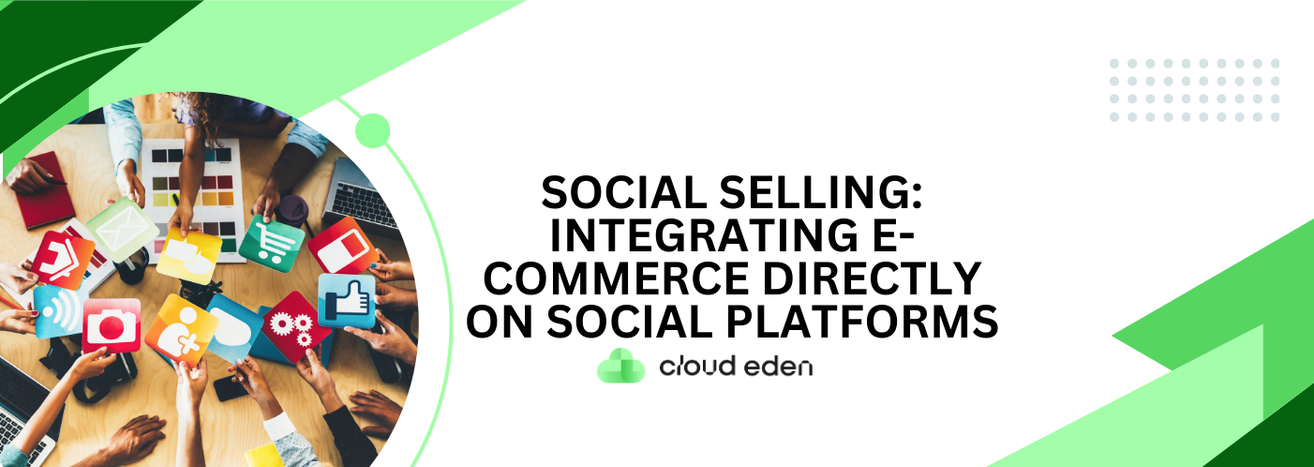Social Selling: Integrating E-commerce Directly on Social Platforms

Table of Contents
1. Introduction
2. What is Social Selling?
3. Why is Social Selling Important?
- Consumer Behavior Has Shifted to Social Media
- Faster and More Convenient Buying Experience
- Better Engagement and Trust
- Personalized Shopping Experience
- Lower Customer Acquisition Costs
4. How to Integrate E-commerce Directly on Social Platforms
- Instagram Shopping
- Facebook Shops & Marketplace
- TikTok Shop & Product Tags
- Pinterest Shopping
- WhatsApp Business & Messenger Commerce
5. Best Practices for Social Selling Success
- Optimize Your Product Listings
- Engage with Your Audience
- Leverage Influencer Marketing
- Run Targeted Ads
- Monitor Performance & Optimize
6. Conclusion
Introduction
Social selling is revolutionizing how businesses reach consumers by integrating e-commerce directly on social media platforms. Instead of leading customers to external websites, brands can now enable users to browse, shop, and complete purchases without leaving their favorite apps.
With billions of active users across platforms like Instagram, Facebook, TikTok, and Pinterest, businesses have an unprecedented opportunity to drive sales through seamless shopping experiences. In this article, we will explore the importance of social selling, its benefits, platform-specific strategies, and best practices to maximize conversions.

What is Social Selling?
Social selling is the practice of using social media to find, engage, and convert customers by integrating e-commerce functionality within the platform itself. Unlike traditional marketing, which relies on external websites or landing pages, social selling allows users to make purchases directly within the app.
Some examples of social selling features include:
Instagram Shops – Businesses can create digital storefronts where users can browse and buy products without leaving Instagram.
Facebook Marketplace & Shops – Facebook allows businesses to showcase products and process payments within the app.
TikTok Shop – Brands and influencers can tag products in videos, enabling direct purchases.
Pinterest Shopping – Pins are now shoppable, turning visual inspiration into instant transactions.
WhatsApp Business & Messenger – Brands can integrate catalogs and payment options within chat apps.
By reducing friction in the buying process, social selling increases impulse purchases, improves conversion rates, and enhances customer experience.
Why is Social Selling Important?
1. Consumer Behavior Has Shifted to Social Media
People spend 2.5+ hours per day on social media, making it a natural place for product discovery and shopping. Unlike traditional e-commerce, where customers must navigate to a separate website, social selling keeps them within the ecosystem they trust.
2. Faster and More Convenient Buying Experience
Shoppers are more likely to complete a purchase when it requires fewer steps. Instead of navigating through multiple checkout pages, social commerce enables one-click or embedded checkout, leading to higher conversion rates.
3. Better Engagement and Trust
Social selling fosters authentic interactions through:
Influencer recommendations – People trust product reviews and unboxings from influencers they follow.
User-generated content (UGC) – Seeing real customers using products builds credibility.
Direct communication – Brands can engage with customers via comments, DMs, and live streams.
4. Personalized Shopping Experience
Social media platforms leverage AI-driven recommendations to suggest products based on user behavior, increasing the likelihood of sales.
5. Lower Customer Acquisition Costs
Compared to traditional PPC ads that drive traffic to external sites, in-app purchases reduce bounce rates and improve return on ad spend (ROAS).
How to Integrate E-commerce Directly on Social Platforms
1. Instagram Shopping
Instagram is one of the most powerful platforms for social selling, offering a seamless shopping experience through:
Shoppable posts & Stories – Businesses can tag products in posts and allow users to tap for purchase.
Instagram Shop – A customizable storefront that displays collections, product details, and checkout options.
Live Shopping – Brands can sell products in real-time during live streams.
How to Set Up Instagram Shopping:
Convert your profile to a Business or Creator account.
Connect a Facebook catalog via Meta Commerce Manager.
Enable Checkout on Instagram (available in select countries).
Start tagging products in posts, Reels, and Stories.
👉 Pro Tip: Use high-quality visuals and product demos to drive sales.
2. Facebook Shops & Marketplace
Facebook offers two major e-commerce solutions:
Facebook Shops – A customizable storefront linked to Instagram and Facebook.
Facebook Marketplace – Great for peer-to-peer selling and local businesses.
How to Set Up a Facebook Shop:
Go to Meta Commerce Manager and create a shop.
Upload your products and categorize them properly.
Enable Checkout on Facebook or link to your website.
Promote products using Facebook Ads, live streams, and influencer collaborations.
👉 Pro Tip: Use Facebook Groups to build a community and sell directly.

3. TikTok Shop & Product Tags
TikTok is a fast-growing e-commerce hub, with TikTok Shop allowing businesses to:
Sell directly via product tags in videos.
Use Live Shopping to showcase products in real-time.
Partner with TikTok influencers to drive sales.
How to Set Up TikTok Shop:
Sign up at TikTok Shop Seller Center.
Upload your products and set pricing.
Enable TikTok Shopping Ads to boost visibility.
Encourage influencers to create shoppable videos.
👉 Pro Tip: Use entertaining content and viral trends to drive sales.
4. Pinterest Shopping
Pinterest is highly visual, making it perfect for product discovery. Businesses can:
Enable Shoppable Pins, which allow direct purchases.
Use Rich Pins to provide pricing and product details.
Run Pinterest Shopping Ads to target engaged buyers.
How to Set Up Pinterest Shopping:
Claim your website and upload a product catalog.
Enable Shop the Look Pins for fashion/home decor items.
Use high-quality lifestyle images to inspire purchases.
👉 Pro Tip: Create Pinterest boards with themed product collections.
5. WhatsApp Business & Messenger Commerce
WhatsApp and Messenger allow businesses to:
Share product catalogs with customers.
Enable direct purchases via chat.
Automate responses using chatbots.
How to Sell on WhatsApp:
Set up a WhatsApp Business profile.
Upload a product catalog and set up payment options.
Use WhatsApp Ads to drive traffic.
👉 Pro Tip: Use personalized messaging and follow-ups to increase sales.
Best Practices for Social Selling Success
✔ Optimize Your Product Listings
Use high-resolution images and videos.
Write compelling product descriptions with keywords.
Highlight benefits and social proof (reviews/testimonials).
✔ Engage with Your Audience
Respond to comments and DMs promptly.
Encourage user-generated content by asking customers to share photos/reviews.
Run interactive polls and giveaways.
✔ Leverage Influencer Marketing
Partner with influencers in your niche.
Use affiliate links or discount codes to track conversions.
✔ Run Targeted Ads
Use lookalike audiences and retargeting ads.
A/B test creatives to improve ad performance.
✔ Monitor Performance & Optimize
Track sales using platform analytics.
Adjust pricing, visuals, and copy based on data.
Conclusion
Social selling is the future of e-commerce, offering businesses a powerful way to connect, engage, and convert customers directly on social media. By leveraging platforms like Instagram, Facebook, TikTok, Pinterest, and WhatsApp, brands can create seamless shopping experiences that boost sales and customer loyalty.
Want to succeed in social selling? Start optimizing your social storefront today, engage with your audience, and leverage data to refine your strategy. 🚀
What’s your experience with social selling? Let me know in the comments!
Welcome To Our Blog





